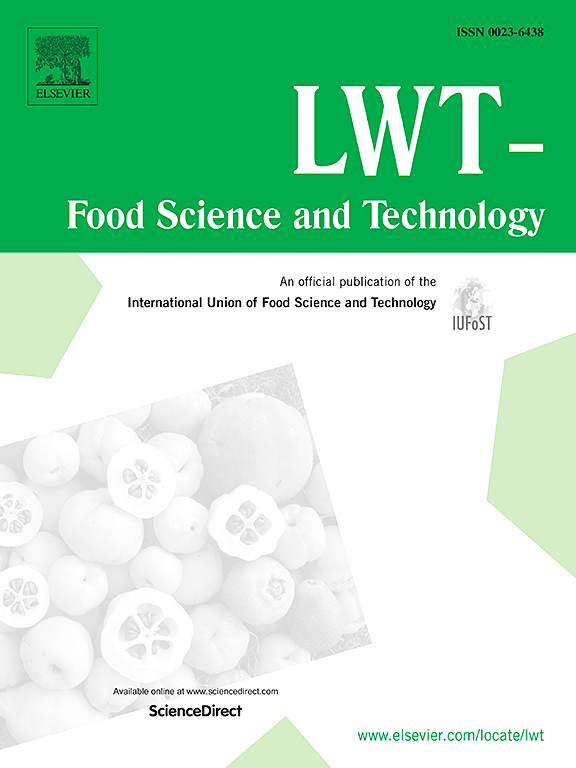软质小麦 Glu-A1、Glu-B1 和 Glu-D1 基因位点单 HMW-GS 缺失的近等基因系的面团特性和烘焙质量
IF 6
1区 农林科学
Q1 FOOD SCIENCE & TECHNOLOGY
引用次数: 0
摘要
由 Glu-1 基因座编码的高分子量谷蛋白亚基(HMW-GSs)是决定小麦加工质量的关键因素。然而,单一高分子量谷蛋白亚基对面团粘弹性和最终使用质量的贡献尚未得到很好的了解,尤其是在软质小麦中。在这项研究中,对五种近等基因系(NIL)软质小麦的籽粒样品进行了调查,每种小麦都有单独的 HMW-GS 空值。与野生型(WT)相比,NILs 的 SDS 沉淀体积和乳酸溶剂保留能力(SRC)明显较低。除了 Glu-D1y12 基因缺失的 NIL 外,与 WT 相比,其他 NIL 的面团搅拌耐受性都明显较低。此外,与 WT 相比,单个 HMW-GS 的缺失与面团弹性和强度的降低有关,但 Glu-A1x1 基因缺失除外。此外,Glu-B1x7 是决定面团混合耐受性和弹性的最重要的 HMW-GS。与 WT 相比,Glu-D1x2、Glu-B1x7 和 Glu-B1y8 的缺失会显著增加肺泡 L,降低肺泡 P 和 P/L 比率。与 WT 相比,所有具有单一 HMW-GS 空位的 NIL 都表现出更好的糖饼烘焙质量。为改善软质小麦面团粘弹性和烘焙质量找到了新的种质和工具。本文章由计算机程序翻译,如有差异,请以英文原文为准。
Dough properties and baking quality of near isogenic lines with single HMW-GS null at Glu-A1, Glu-B1 and Glu-D1 loci in soft wheat
High molecular weight glutenin subunits (HMW-GSs) encoded by the Glu-1 loci are key factors in determining wheat processing quality. However, the contributions of single HMW-GS to dough viscoelastic properties and end-use quality have not been well understood, especially in soft wheat. In this study, the kernel samples of five Near Isogenic Lines (NILs) of a soft wheat each with individual HMW-GS null were investigated. Significant lower SDS-sedimentation volume and lactic acid solvent retention capacity (SRC) were observed in the NILs, compared to the wild type (WT). Except for the NIL with Glu-D1y12 null, the other NILs were associated with significantly lower dough mixing tolerance compared to the WT. Also, the deletion of individual HMW-GS was associated with reduction in dough elasticity and strength, compared to the WT, with the exception of the Glu-A1x1 null. Moreover, Glu-B1x7 was the most important HMW-GS in determining dough mixing tolerance and elasticity. Compared to the WT, the deletions of Glu-D1x2, Glu-B1x7 and Glu-B1y8 significantly increased alveograph L, and decreased alveograph P and P/L ratios. All NILs with single HMW-GS null showed better sugar snap cookie baking quality than the WT. New germplasm and tools are identified for improving dough viscoelasticity and baking quality in soft wheat.
求助全文
通过发布文献求助,成功后即可免费获取论文全文。
去求助
来源期刊

LWT - Food Science and Technology
工程技术-食品科技
CiteScore
11.80
自引率
6.70%
发文量
1724
审稿时长
65 days
期刊介绍:
LWT - Food Science and Technology is an international journal that publishes innovative papers in the fields of food chemistry, biochemistry, microbiology, technology and nutrition. The work described should be innovative either in the approach or in the methods used. The significance of the results either for the science community or for the food industry must also be specified. Contributions written in English are welcomed in the form of review articles, short reviews, research papers, and research notes. Papers featuring animal trials and cell cultures are outside the scope of the journal and will not be considered for publication.
 求助内容:
求助内容: 应助结果提醒方式:
应助结果提醒方式:


